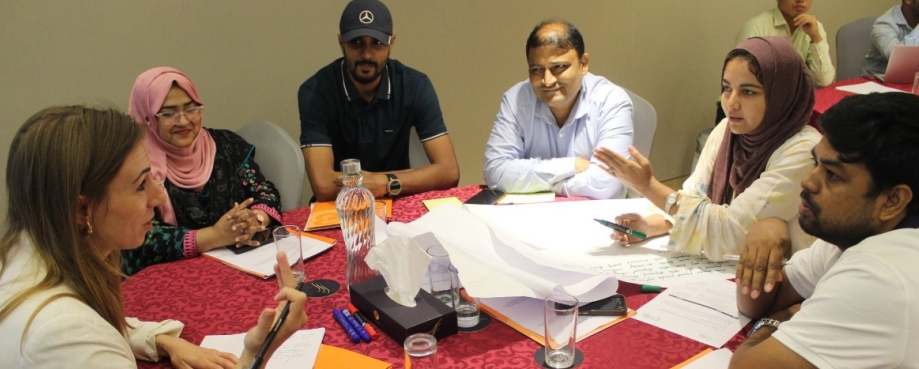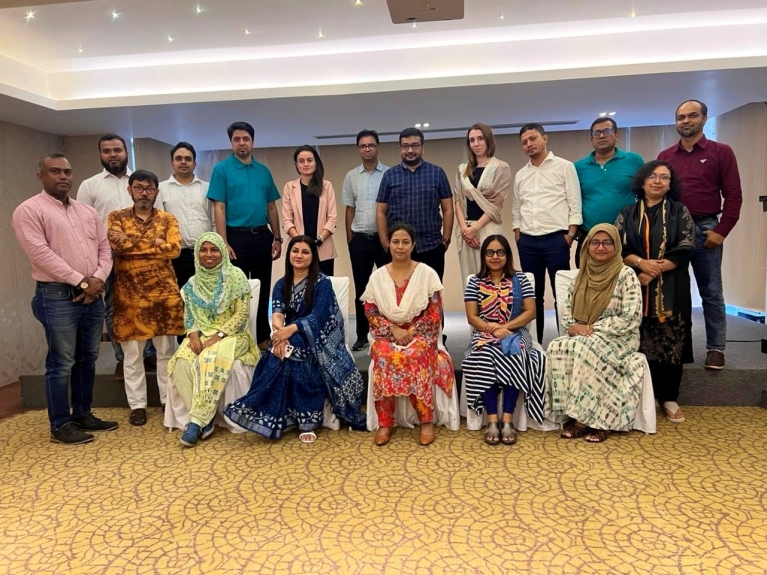
Building on last year’s conversations, I returned to India and Bangladesh to share how we acted on the feedback gathered in 2024 and take the next steps on our journey towards responsible purchasing practices.
Last year, we explored the challenges faced by suppliers and workers, and the barriers to fair and sustainable production.
This year, I was joined by my colleague Margherita Parodi. Together, we engaged with 113 suppliers, 18 association representatives and board members from the Tirrupur Export Association (TEA) and BKMEA, 40 trade union leaders, and 16 brand representatives.
The focus this year shifted to action and accountability: explaining the steps we have taken, highlighting our work on accountability in purchasing practices, and discussing how this all ties into upcoming legislation affecting the industry.
What stakeholders have shared
Through our workshops, one-to-one interviews, and presentations, we heard directly from suppliers, union leaders, brand representatives, and association members. This year, we also had the privilege of speaking directly with workers about the challenges they continue to face in the apparel and textile industry. The discussions highlighted recurring patterns and systemic pressures that make it difficult to uphold environmental and labour standards.
These tight deadlines push us to the limit, and then they wonder why we need to subcontract or why workers burn out.
Pricing and rising costs
A consistent theme across suppliers was the tension between pricing, compliance costs, and the ability to provide decent wages and sustainable operations.
Suppliers described how buyers often request samples based on target prices for large orders, only to reduce quantities and lower prices once the orders are confirmed. One supplier shared: “They ask me to give a price based on a sample for a quantity of 10,000 pieces. After confirmation they reduce the order — and even expect me to reduce the price.”
Another explained: “When we set a price for a product, next season for the same product, same fabric, same colour, buyers come back and ask for lower prices. It is an actual race to the bottom.”
Unpredictability and lack of commitment from brands also came up repeatedly: “Brands keep moving to different suppliers, always searching for the cheapest option. But the lower you go, the harder it becomes to comply with human rights and environmental standards — because compliance costs money.”
Suppliers emphasised that this uncertainty directly affects their ability to invest in living wages, social compliance, and environmental sustainability. As one noted: “We want an industry that is sustainable, but how can we expect production countries to invest in living wages and environmental sustainability when there is no commitment to pay a production price that enables a living wage?”
Unions reflected that social and environmental compliance carries costs — costs that cannot be borne by suppliers and workers alone. They argued that brands must be held accountable for the way they buy, ensuring that purchasing practices reflect the true price of responsible production.
Brands recognised the challenge of balancing global standards with local realities. One representative explained: “HQ also needs to understand that we live in two realities — our countries are different from their countries. We are constantly in the middle, mediating that. With requirements going up, of course that comes with a cost, as our countries are not ready for it yet.”
Another added: “We want suppliers to meet environmental and social standards, but we also have to recognise that pricing, lead times and order predictability directly affect what they can deliver. We are constantly trying to find the balance.”
Brand representatives emphasised that accountability cannot be achieved through audits alone — it requires dialogue, clarity, and shared responsibility with suppliers and unions.
Commitment and business predictability
Suppliers also emphasised that consistency in orders is critical. One supplier noted: “Business predictability might be even more important than price. If we cannot rely on consistent orders, it is impossible to plan production, manage workers, or invest in improvements.”
Reflecting on last year, political unrest in Bangladesh temporarily shifted production to India. This year, new challenges emerged as US tariffs hit India, with suppliers reporting brands exiting the market altogether. These shifts underscore the fragility of supplier–buyer relationships and the difficulty of sustaining investments in decent wages and job security.
Unions emphasised that these changes disproportionately affect the workforce, particularly in an industry already heavily reliant on migrant workers, creating additional instability and stress — an environment that does not work towards betterment and partnership, but to ‘best price’.
Lead times and production pressure
Tight and unrealistic lead times remain a major concern. Suppliers described being asked to complete orders in half the time they realistically require, even with extended work hours: “Lead times are just not realistic. If an order should take 100 days, they ask for it in 50 days. Even if my workers put in 10-hour days, six days a week, on high intensive work, it is impossible. These tight deadlines push us to the limit, and then they wonder why we need to subcontract {often in poor conditions} or why workers burn out.”
Unions highlighted that compressed schedules increase stress, excessive overtime, and turnover among workers, creating additional challenges for worker well-being. Many union leaders observed rising pressure on workers, leading to more health issues and anxiety.
Sharing grievances
Another recurring theme was the risk suppliers face when raising concerns or sharing challenges. Several suppliers reported feeling unable to voice issues for fear of losing business. One shared: “We cannot openly share our challenges — when we do, we risk losing business. A few months ago, I had an issue at my factory and shared it with my customers. We resolved it, but then they left. What does that mean for responsible business? Why would I raise concerns if this is the response?”
Unions described the practical challenges of raising grievances. Many workers are unaware of which brands source from their factory, which limits their ability to escalate issues beyond the workplace. Union meetings often serve as the main platform for workers to discuss wages, overtime, harassment, and gender-based violence. However, without clear information or safe channels, it is difficult to connect these concerns to buyer accountability.
Brands also shared that suppliers do not always raise issues formally. Often concerns are shared informally in personal conversations, but when department heads or formal representatives are involved, suppliers may present everything as perfect. This makes it difficult for brands to identify and address issues effectively.
Several union leaders emphasised that frameworks and legislations such as CSDDD and compliance requirements must be explained in simpler terms, ideally with examples and case studies, so they can make a real difference on the ground.

Audit burden and compliance fatigue
Suppliers also raised concerns about the overwhelming number of audits and compliance requirements — both environmental and social. Many audits are redundant, conducted even when suppliers do not have active orders, and often fail to provide meaningful improvements. With new legislation and emerging standards, suppliers feel that responsibility is increasingly cascaded down to them, even when they lack the resources or support to meet these requirements effectively.
Brands acknowledged this tension. One representative said: “We want suppliers to meet standards, but we also have to recognise the practical constraints they face. It’s not always straightforward to balance local realities with global requirements.”
What workers shared
This year, we had the opportunity to speak directly with worker committee representatives about their current lived experiences in the factory. Many expressed that they were generally happy working there, with some having been at the factory for 12 years. We explained the project and what we hope to achieve, and asked workers what they think brands could do to support better working conditions.
Some workers mentioned practical support, such as providing snacks or assistance for expectant mothers. Others highlighted the importance of predictable and consistent orders, which allow for stable working hours and enable them to plan and invest in their own lives — for example, taking out loans to support children’s education or to improve their homes.
We also asked about areas where they would like to see improvements. While overtime is currently necessary to meet wages, workers noted that if salaries were sufficient, they would like to spend more time with their families, work fewer hours, and have more rest. This conversation provided valuable insight into their priorities and the ways brands could contribute to better conditions.
Why this matters now
Responsible purchasing practices are no longer just “good practice” — they are increasingly tied to legislation and accountability mechanisms. Upcoming regulations, such as the Corporate Sustainability Due Diligence Directive (CSDDD), make it clear that brands must ensure their purchasing practices and operations do not compromise human and environmental rights.
Listening to key stakeholders in apparel and textile supply chains is essential to understanding how they are affected by current practices, identifying ways to correct harmful practices, and using these insights to shape company policies and legal standards.
Introducing the Purchasing Practices HRDD Framework
The RPP Working Group recently launched the Purchasing Practices HRDD Framework, a recommendation for key actors seeking to hold purchasing companies accountable for responsible business conduct, including policymakers, regulators, multi-stakeholder initiatives, and investors. The framework sets out core requirements of companies to ensure their purchasing practices are informed by international HRDD standards: the UN Guiding Principles on Business and Human Rights (UNGPs) and the OECD Guidelines for Responsible Business Conduct.
The framework is not a standalone accountability tool or auditing exercise. Rather, it provides fundamental elements to be incorporated into:
- HRDD legislation and related compliance processes
- Investor assessments
- Existing accountability mechanisms managed by MSIs and third parties
Organisations can use it as a gap analysis tool — comparing current assessment mechanisms against the framework’s requirements to ensure completeness. By establishing clear, specific steps, the Purchasing Practices HRDD Framework aims to contribute to greater transparency, comparability, and accountability across the industry.
Reflections and learnings
Reflecting on this year’s engagement, several key lessons stand out:
Trust is critical. Suppliers, unions, and brand representatives navigate complex realities. Trust is built when concerns are acknowledged, risks are shared, and actions follow dialogue — and when openness is incentivised rather than punished.
Systemic change requires multi-stakeholder collaboration. Suppliers cannot bear responsibility alone. Brands must align purchasing practices with sustainability goals, and unions and associations play a critical role in representing workers and supporting capacity-building. Governments must also create enabling environments that reinforce these efforts.
Worker voice is essential. Many workers do not know which brands they produce for, and migrant workers in particular often lack rights or systems to raise concerns. For legislation and frameworks to deliver, workers and their representatives must have safe, accessible, and meaningful channels to speak up.
Legislation and frameworks create opportunity — if implemented well. Global markets require global responsibility. If we want supply chains that are environmentally sustainable and uphold human rights, purchasing practices must reflect these commitments at every level — from raw materials to the finished product.
The RPP Working Group — which includes ETI — has recently launched the Responsible Purchasing Practices (RPP) Resource Hub and the Purchasing Practices Human Rights Due Diligence (HRDD) Framework. These resources build on the Common Framework for RPP to support responsible purchasing across the industry. Going forward, ETI will continue to focus on advocating for mandatory HRDD and supporting practical implementation — aligning international and local law, researching supplier grievance mechanisms, and providing guidance on responsible disengagement and order reduction. These initiatives are strengthened through the collective action of ETI members, who are able to share learning, test approaches in practice, and drive progress together across sectors.
If you are interested in joining, get in touch with: melissa.karadana@eti.org.uk
